|
|
Our Holy Father Auxentius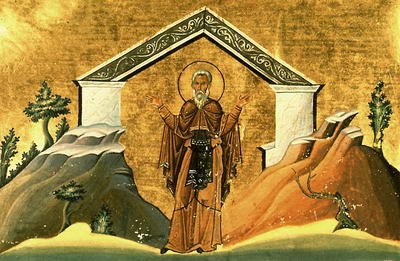 A very distinguished administrator in Constantinople among the officials and courtiers of the Emperor Theodosius the Younger, he was set aflame by the love of Christ. Auxentius became a monk and remained only a short time in Constantinople. When men began to praise him, he fled and settled on a mountain near Chalcedon that later became known as Auxentius"s mountain. He could not realise his desire to remain there permanently, hidden from men, as some shepherds found him and made his whereabouts known. They began to bring the sick to him to be healed, and he healed many of them. He restored sight to the blind and cleansed lepers, anointing them with oil. He also raised up the palsied and freed many who had been possessed by demons. All this was cause for wonder, but his humility was more wonderful. When he was asked to pray for the healing of someone, he excused himself with the words: "I also am a sinful man." But, constrained by many requests, he approached the healing in the following way: either he called all present to pray with him for the sick person, or he first stirred up the faith of the people and told them that God would give according to their faith, or he said over the head of the sick person: "The Lord Jesus Christ heals you." He did this that the wonder worked should not be attributed to him but to almighty God. He took part in the Fourth Ecumenical Council at Chalcedon and powerfully defended Orthodoxy against the Eutychian and Nestorian heresies. He lived to a great age; then, in 470, God took his youthful soul to Himself and left his aged body on the earth from which it was made. A very distinguished administrator in Constantinople among the officials and courtiers of the Emperor Theodosius the Younger, he was set aflame by the love of Christ. Auxentius became a monk and remained only a short time in Constantinople. When men began to praise him, he fled and settled on a mountain near Chalcedon that later became known as Auxentius"s mountain. He could not realise his desire to remain there permanently, hidden from men, as some shepherds found him and made his whereabouts known. They began to bring the sick to him to be healed, and he healed many of them. He restored sight to the blind and cleansed lepers, anointing them with oil. He also raised up the palsied and freed many who had been possessed by demons. All this was cause for wonder, but his humility was more wonderful. When he was asked to pray for the healing of someone, he excused himself with the words: "I also am a sinful man." But, constrained by many requests, he approached the healing in the following way: either he called all present to pray with him for the sick person, or he first stirred up the faith of the people and told them that God would give according to their faith, or he said over the head of the sick person: "The Lord Jesus Christ heals you." He did this that the wonder worked should not be attributed to him but to almighty God. He took part in the Fourth Ecumenical Council at Chalcedon and powerfully defended Orthodoxy against the Eutychian and Nestorian heresies. He lived to a great age; then, in 470, God took his youthful soul to Himself and left his aged body on the earth from which it was made.Our Holy Father Isaac the Recluse, of the Kiev Caves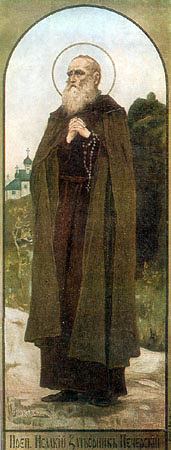 Isaac was a contemporary of Saints Antony and Theodosius. He came to the monastery as a rich merchant, but forsook everything, giving all his goods to the poor, and gave himself to the strictest asceticism in a walled-in cell. Only St Antony gave him a blessed loaf through the window every other day. Deluded by demons, who appeared to him as angels of light, he worshipped them, and then Satan himself, believing hat he was Christ. As a result of this he became ill and lay two years in sickness, after which he was healed and became a cautious and experienced ascetic, receiving in the end abundant blessings. He entered into rest in 1090. Isaac was a contemporary of Saints Antony and Theodosius. He came to the monastery as a rich merchant, but forsook everything, giving all his goods to the poor, and gave himself to the strictest asceticism in a walled-in cell. Only St Antony gave him a blessed loaf through the window every other day. Deluded by demons, who appeared to him as angels of light, he worshipped them, and then Satan himself, believing hat he was Christ. As a result of this he became ill and lay two years in sickness, after which he was healed and became a cautious and experienced ascetic, receiving in the end abundant blessings. He entered into rest in 1090.Repose of St Cyril, Equal of the Apostles and Teacher of the Slavs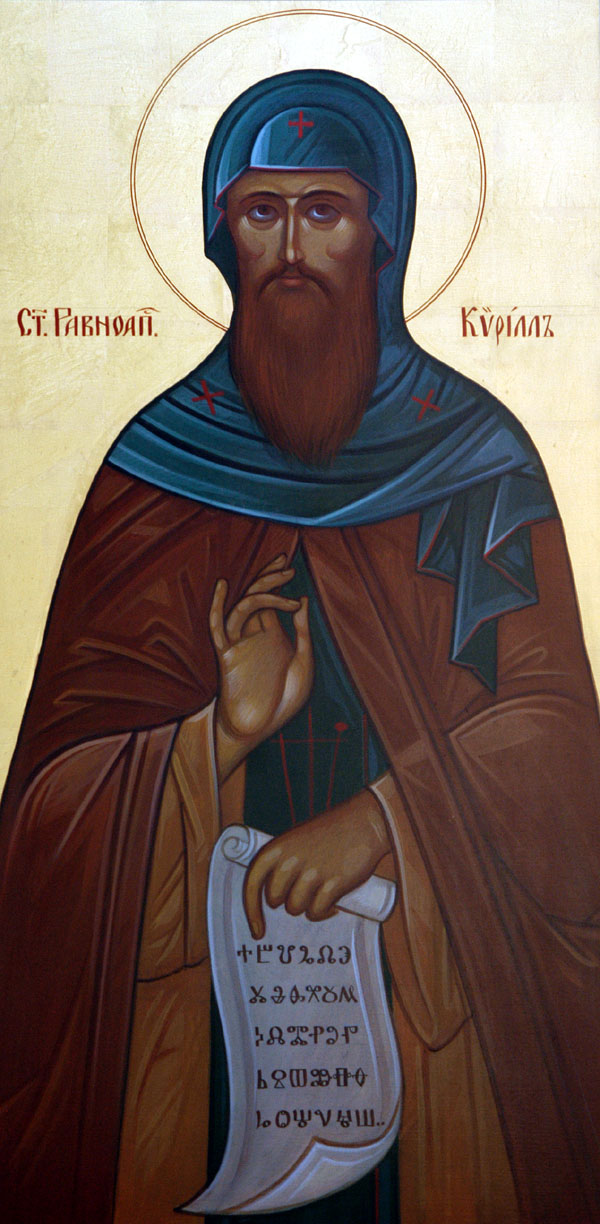 Saint Cyril Equal of the Apostles, Teacher of the Slavs (Constantine in the schema), and his older brother Methodius (April 6), were Slavs, born in Macedonia in the city of Thessalonica.
St Cyril received the finest of educations, and from the age of fourteen he was raised with the son of the emperor. Later, he was ordained as a priest. Upon his return to Constantinople, he worked as a librarian of the cathedral church, and as a professor of philosophy. St Cyril successfully held debates with iconoclast heretics and with Moslems.
Yearning for solitude, he went to Mount Olympos to his older brother Methodius, but his solitude lasted only a short while. Both brothers were sent by the emperor Michael on a missionary journey to preach Christianity to the Khazars in the year 857. Along the way they stopped at Cherson and discovered the relics of the Hieromartyr Clement of Rome (November 25).
Arriving at the territory of the Khazars, the holy brothers spoke with them about the Christian Faith. Persuaded by the preaching of St Cyril, the Khazar prince together with all his people accepted Christianity. The grateful prince wanted to reward the preachers with rich presents, but they refused this and instead asked the prince to free and send home with them all the Greek captives. St Cyril returned to Constantinople together with 200 such captives set free.
In the year 862 began the chief exploit of the holy brothers. At the request of Prince Rostislav, the emperor sent them to Moravia to preach Christianity in the Slavic language. Sts Cyril and Methodius by a revelation from God compiled a Slavonic alphabet and translated the Gospel, Epistles, the Psalter and many Service books into the Slavonic language. They introduced divine services in Slavonic.
The holy brothers were then summoned to Rome at the invitation of the Roman Pope. Pope Adrian received them with great honor, since they brought with them the relics of the Hieromartyr Clement. Sickly by nature and in poor health, St Cyril soon fell ill from his many labors, and after taking the schema, he died in the year 869 at the age of forty-two. Before his death, he expressed his wish for his brother to continue the Christian enlightenment of the Slavs. St Cyril was buried in the Roman church of St Clement, whose own relics also rest there, brought to Italy from Cherson by the Enlighteners of the Slavs. Saint Cyril Equal of the Apostles, Teacher of the Slavs (Constantine in the schema), and his older brother Methodius (April 6), were Slavs, born in Macedonia in the city of Thessalonica.
St Cyril received the finest of educations, and from the age of fourteen he was raised with the son of the emperor. Later, he was ordained as a priest. Upon his return to Constantinople, he worked as a librarian of the cathedral church, and as a professor of philosophy. St Cyril successfully held debates with iconoclast heretics and with Moslems.
Yearning for solitude, he went to Mount Olympos to his older brother Methodius, but his solitude lasted only a short while. Both brothers were sent by the emperor Michael on a missionary journey to preach Christianity to the Khazars in the year 857. Along the way they stopped at Cherson and discovered the relics of the Hieromartyr Clement of Rome (November 25).
Arriving at the territory of the Khazars, the holy brothers spoke with them about the Christian Faith. Persuaded by the preaching of St Cyril, the Khazar prince together with all his people accepted Christianity. The grateful prince wanted to reward the preachers with rich presents, but they refused this and instead asked the prince to free and send home with them all the Greek captives. St Cyril returned to Constantinople together with 200 such captives set free.
In the year 862 began the chief exploit of the holy brothers. At the request of Prince Rostislav, the emperor sent them to Moravia to preach Christianity in the Slavic language. Sts Cyril and Methodius by a revelation from God compiled a Slavonic alphabet and translated the Gospel, Epistles, the Psalter and many Service books into the Slavonic language. They introduced divine services in Slavonic.
The holy brothers were then summoned to Rome at the invitation of the Roman Pope. Pope Adrian received them with great honor, since they brought with them the relics of the Hieromartyr Clement. Sickly by nature and in poor health, St Cyril soon fell ill from his many labors, and after taking the schema, he died in the year 869 at the age of forty-two. Before his death, he expressed his wish for his brother to continue the Christian enlightenment of the Slavs. St Cyril was buried in the Roman church of St Clement, whose own relics also rest there, brought to Italy from Cherson by the Enlighteners of the Slavs. Venerable Maron the Hermit of Syria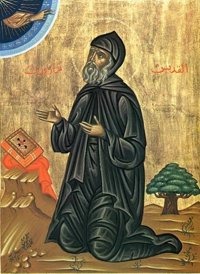 Saint Maron was born in the fourth century near the city of Cyrrhus in Syria. He spent almost all his time beneath the open sky in prayer, vigil, ascetical works and strict fasting. He obtained from God the gift of healing the sick and casting out demons. He counselled those who turned to him for advice to be temperate, to be concerned for their salvation, and to guard against avarice and anger.
St Maron, a friend of St John Chrysostom, died before 423 at an advanced age.
Some of St Maron’s disciples were James the Hermit (November 26), Limnius (February 23), and Domnina (March 1). St Maron founded many monasteries around Cyrrhus, and converted a pagan temple near Antioch into a Christian church. Saint Maron was born in the fourth century near the city of Cyrrhus in Syria. He spent almost all his time beneath the open sky in prayer, vigil, ascetical works and strict fasting. He obtained from God the gift of healing the sick and casting out demons. He counselled those who turned to him for advice to be temperate, to be concerned for their salvation, and to guard against avarice and anger.
St Maron, a friend of St John Chrysostom, died before 423 at an advanced age.
Some of St Maron’s disciples were James the Hermit (November 26), Limnius (February 23), and Domnina (March 1). St Maron founded many monasteries around Cyrrhus, and converted a pagan temple near Antioch into a Christian church. St Abraham the Bishop of Charres in Mesopotamia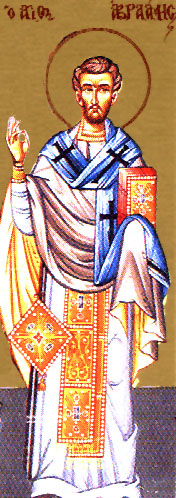 Saint Abraham, Bishop of Charres, lived during the mid-fourth and early fifth centuries, and was born in the city of Cyrrhus. In his youth he entered a monastery. Later he became a hermit in Lebanon, a place where many pagans lived.
St Abraham suffered much vexation from the pagans, who wanted to expel him from their area. He once saw tax-collectors beating those who were unable to pay. Moved to pity, he paid the taxes for them, and those people later accepted Christ.
The Christian inhabitants of this village built a church and they fervently besought St Abraham to accept the priesthood and become their pastor. The monk fulfilled their wish. Having encouraged his flock in the faith, he left them in place of himself another priest, and he again retired to a monastery.
For his deep piety he was made bishop of Charres; his pastors the saint constantly taught by his God-pleasing life. From the time of his accepting of the priesthood, he never used cooked food. The emperor Theodosius the Younger wanted to meet the bishop and made him an invitation. After he arrived in Constantinople, St Abraham soon died. His remains were solemnly transferred to the city of Charres and there given over to burial. Saint Abraham, Bishop of Charres, lived during the mid-fourth and early fifth centuries, and was born in the city of Cyrrhus. In his youth he entered a monastery. Later he became a hermit in Lebanon, a place where many pagans lived.
St Abraham suffered much vexation from the pagans, who wanted to expel him from their area. He once saw tax-collectors beating those who were unable to pay. Moved to pity, he paid the taxes for them, and those people later accepted Christ.
The Christian inhabitants of this village built a church and they fervently besought St Abraham to accept the priesthood and become their pastor. The monk fulfilled their wish. Having encouraged his flock in the faith, he left them in place of himself another priest, and he again retired to a monastery.
For his deep piety he was made bishop of Charres; his pastors the saint constantly taught by his God-pleasing life. From the time of his accepting of the priesthood, he never used cooked food. The emperor Theodosius the Younger wanted to meet the bishop and made him an invitation. After he arrived in Constantinople, St Abraham soon died. His remains were solemnly transferred to the city of Charres and there given over to burial. New Martyr Nicholas of Corinth (1554)New Monk-martyr Damian the New of Philotheouwho suffered at Larissa (1568)
Hieromartyr Philemon, bishop of Gaza
New Martyr George the Tailor of Mitylene, at Constantinople (1693)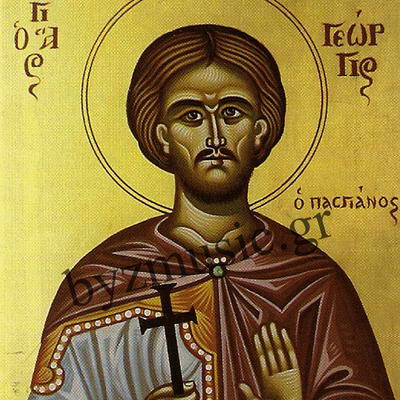 A tailor in the city of Mitylene, the Turks beheaded him after torturing him for his faith and confession in Jesus Christ, and refusal to accept Islam in Constantinople in 1693. A tailor in the city of Mitylene, the Turks beheaded him after torturing him for his faith and confession in Jesus Christ, and refusal to accept Islam in Constantinople in 1693. |